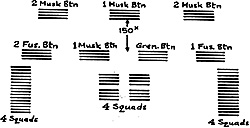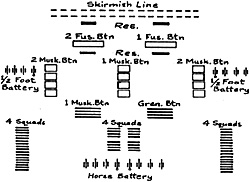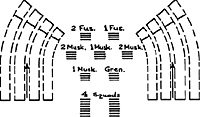Mixed Brigades
 The "attack column" was a more flexible formation than the line as it could respond to a change in circumstances more rapidly (at right, bayonet attack formation). At Jena and Auerstaedt the Prussian lines proved vulnerable to flank attacks from the French cavalry. A column was much more capable of offering an effective defense in such circumstances than a
line.
The "attack column" was a more flexible formation than the line as it could respond to a change in circumstances more rapidly (at right, bayonet attack formation). At Jena and Auerstaedt the Prussian lines proved vulnerable to flank attacks from the French cavalry. A column was much more capable of offering an effective defense in such circumstances than a
line.
Moreover, it was a good deal easier to co-ordinate a number of battalion columns than the same number of lines and thus from 1809 the brigades practiced combined maneuvers. These brigade-level formations are illustrated in the 'Reglement' of 1812.
 The elements of the attack were thus a skirmish line with a close-order support whose function was to open the battle with the enemy and probe his defenses (brigade attack formation at left). Only a part of the fusiliers were deployed in open order at any one
time. The main battle line consisted of three musketeer battalions which were to launch a bayonet attack at the appropriate moment. The reserve consisted of the brigade's senior musketeer battalion (1st of the senior regiment) and the grenadiers.
The elements of the attack were thus a skirmish line with a close-order support whose function was to open the battle with the enemy and probe his defenses (brigade attack formation at left). Only a part of the fusiliers were deployed in open order at any one
time. The main battle line consisted of three musketeer battalions which were to launch a bayonet attack at the appropriate moment. The reserve consisted of the brigade's senior musketeer battalion (1st of the senior regiment) and the grenadiers.
The cavalry and artillery were to be used according to circumstances. Once the enemy defenses had been broken down, the fusliers would fall back and reform in column on the flanks of the second wave. The first wave would close in and if a skirmish element was still required, the third rank of the musketeer battalions was used.
Should the brigade be threatened by enemy cavalry,
the battalions were to form square while the support
cavalry were deployed to deal with them.
This article appears in MagWeb (Magazine Web) on the Internet World Wide Web. At right, brigade defense against cavalry
At right, brigade defense against cavalry
Back to Table of Contents -- Courier Vol. IV No. 2
© Copyright 1982 by The Courier Publishing Company.
Other military history articles and gaming articles are available at http://www.magweb.com